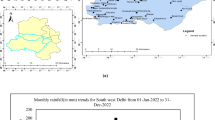Abstract
Radioactive tracers which have several advantages over conventional tracers made significant contributions to the development of the injected tracer method in hydrology. A review of the nuclear and the physico-chemical characteristics of the possible radiotracer compounds leads us to conclude that the most effective groundwater tracers are tritiated water (HTO),82Br− and58Co or60Co as a hexacyanocobaltate complex.
A discussion of the various case studies in India and abroad covering the three groups of applications mentioned helps us to conclude that well established radiotracer methods with associated interpretational techniques are available for many short range studies in surface and subsurface hydrology.
Similar content being viewed by others
References
Athavale R N 1980Proc. workshop on Nucl. Tech. Hydrol., NGRI, Hyderabad pp. 59
Athavale R N, Murti C S and Chand R 1980J. Hydrol. 45 85
Beherns H 1983Tracer methods in Isotope Hydrology. IAEA-TECDOC-291, IAEA, Vienna pp. 173
Datta P S, Desai B I, Gupta S K 1980Proc. Indian Natl. Sci. Acad. A46 84
Datta P S, Goel P S, Rama and Singal S P 1973Proc. Indian Acad. Sci. (Earth Planet. Sci.) 78 1
Deshpande R G, Rao S M, Jain S K, Nair A R 1980Proc. Workshop on Nuclear Techniques in Hydrology, NGRI, Hyderabad, pp. 211
Drost W, Moser H, Neumaier F, Rauert W 1974Isotope methods in groundwater hydrology, Eurisotop Information Booklet No. 6, Eurisotop, Brussels
Eapen A C, Rao S M 1967ISI Bull. 19 358
Gaudet J P, Jegat H, Vachaud G, Wierenga P J 1977Soil. Sci. Soc. Am. J. 41 665
Gillham R W, Cherry J A 1982Geol. Soc. Am., (special paper)189 31
Gilath Ch, Stuhl Z 1971Proc. Symp Nucl. Tech. Environ. Pollution, Salzburg 1970, IAEA, Vienna, pp. 483
Goel P S, Datta P S, Rama, Sangal S P, Hans Kumar, Prakash Bahadur, Subharwal R K, Tanwar B S 1975Proc. Indo-German Workshop on approaches and methodologies in development of groundwater resources, Hyderabad, India, p. 309
Guidebook on nuclear technique in hydrology 1983 Tech. Rep. Series No. 91,IAEA, Vienna
Iya V K, Krishnamurthy K, Aggarwal K S, Rajagopalan R 1967Int. J. Appl. Radiat, Isot. 18 349
Jain S K, Navada S V, Nair A R, Rao S M 1980Proc. Workshop on Nucl. Tech. Hydrol., NGRI, Hyderabad pp. 231
Jain S K, Santra A B, Kulkarni U P, Rao S M 1980Proc. Workshop Nucl. Tech. Hydrol., NGRI, Hyderabad, pp. 164
Klotz D, Moser H, Trimborn P 1979Proc. Symp. Neuherberg 1978, Vol. 2, IAEA, Vienna pp. 159
Knutsson G, Forsberg H G 1967Proc. Symp. isotopes in hydrol. IAEA, Vienna pp. 629
Kreft A, Lenda A, Turek B, Zuber A, Czanderna K 1974Proc. Symp. isotope tech. groundwater hydrol., Vol. II, IAEA, Vienna pp. 295
Krishnamurthy K, Rao S M 1969J. Hydrol. 9 277
Maloszewski P, Zuber A 1983 Interpretation of artificial and environmental tracers in fissured rocks with a porous matrix, Report No. 1221/AP,Inst. Nucl. Phys. Krakow, Poland
Mazor E 1976 The Ram Crater Lake—A note on the revival of a 2000-year-old groundwater tracing experiment, Interpretation of Environmental Isotope and Hydrochemical Data in Groundwater Hydrology, IAEA, Vienna pp. 179
Meyer B R, Bain C A R, De Jesus A S H, Stephenson D 1981J. Hydrol. 50 259
Navada S V, Kulkarni U P, Rao S M 1983Trace Analysis and Technological Development (New Delhi: Wiley Eastern Limited) pp. 257
Radhakrishnan A R, Pendharkar A S, Navada S V, Rao S M 1979Proc. Symp. Neuherberg 1978, Vol. 2, IAEA, Vienna, pp. 803
Rao S M 1975Proc. Indo-German workshop on approaches—and methodologies for development of groundwater resources, NGRI, Hyderabad pp. 323
Rao S M 1983Tracer methods in isotope hydrology, IAEA-TECDOC-291, IAEA, Vienna pp. 47
Ravendranath, Mahajan N M, Vaidya S D 1980Proc. Workshop on nucl. tech. Hydrol., NGRI Hyderabad pp. 279
Payne B R 1983Tracer methods in isotope hydrology, IAEA-TECDOC-291, IAEA, Vienna pp. 157
Zojer H 1983Tracer methods in isotope hydrology, IAEA-TECDOC-291, IAEA, Vienna pp. 165
Zuber A 1983Tracer methods in isotope hydrology, IAEA-TECDOC-291, IAEA, Vienna pp. 67
Author information
Authors and Affiliations
Rights and permissions
About this article
Cite this article
Rao, S.M. Injected radiotracer techniques in hydrology. Proc. Indian Acad. Sci. (Earth Planet Sci.) 93, 319–335 (1984). https://doi.org/10.1007/BF02839166
Issue Date:
DOI: https://doi.org/10.1007/BF02839166




